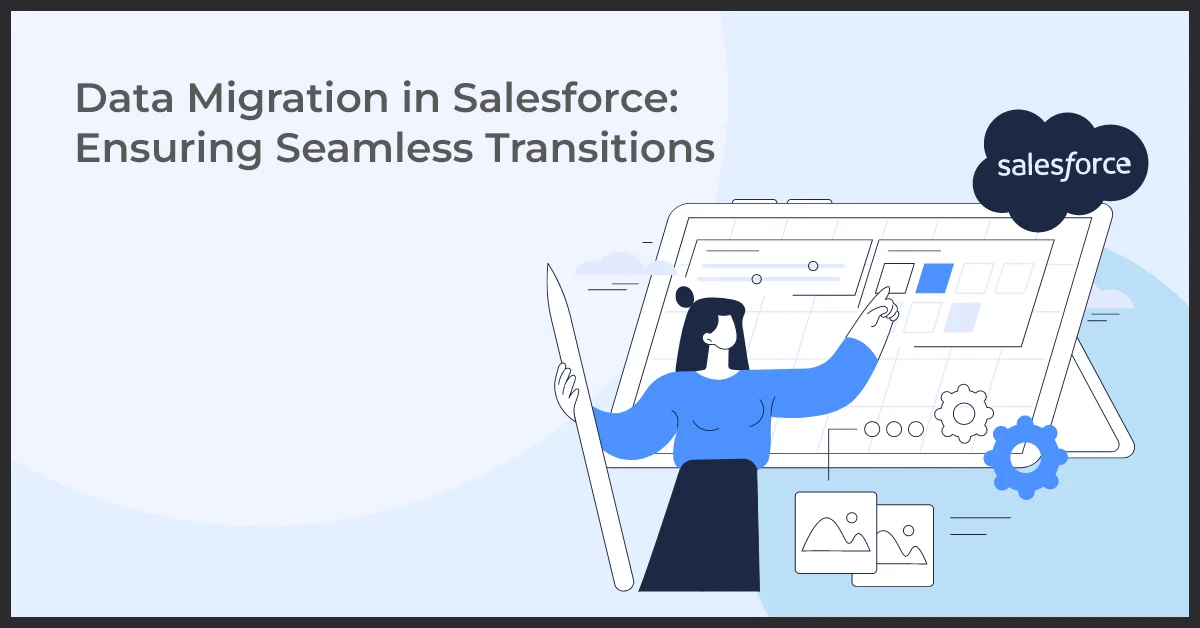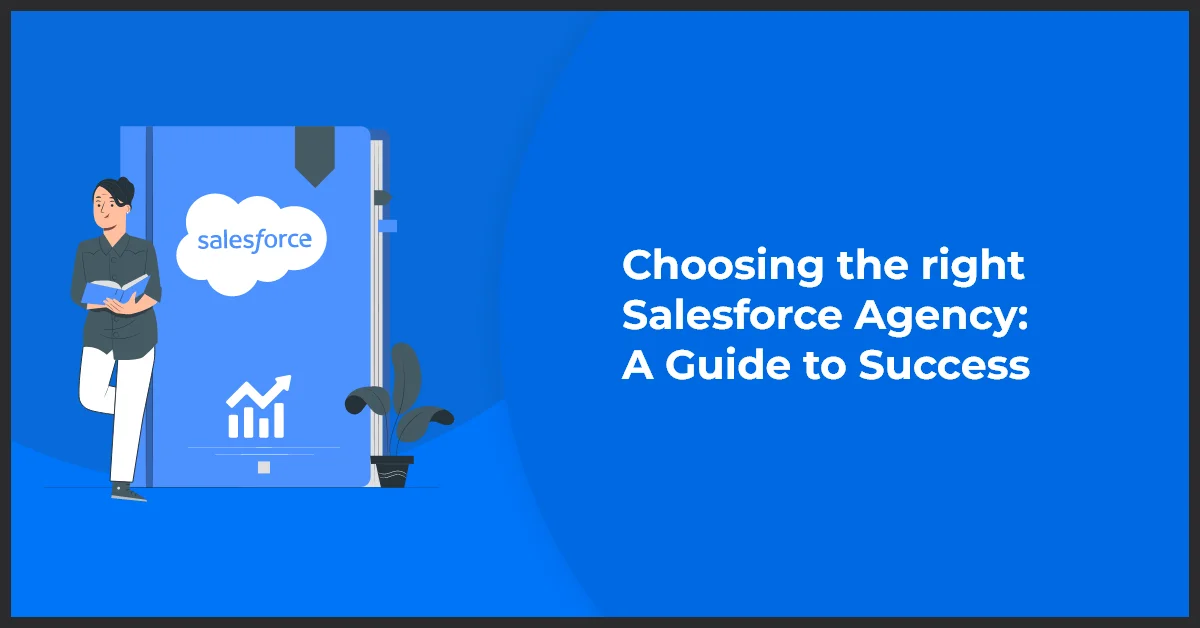Seamless Transitions: Mastering Data Migration in Salesforce

Published on: November 15, 2023
Updated on: January 22, 2025
2373 Views
- Salesforce
13 min read
Data migration is crucial for Salesforce, the leading Customer Relationship Management (CRM) platform. In this article, we'll explore the importance of data migration in Salesforce and its significance in managing customer relationships and business data.
As businesses grow and evolve, transferring data from legacy systems or other CRM platforms to Salesforce becomes essential. Data migration involves transferring data from one system to another while ensuring accuracy, completeness, and integrity. This process is vital as it guarantees a smooth transition, allowing businesses to continue leveraging Salesforce's powerful capabilities without interruption.
Salesforce, known for its user-friendly interface and robust functionalities, is a centralized platform for managing customer relationships and critical business data. It empowers organizations to streamline sales, marketing, and customer service processes, providing real-time insights and driving growth.
With Salesforce, businesses can track customer interactions, manage leads and opportunities, automate workflows, and gain actionable intelligence through advanced analytics. However, ensuring efficient data migration is paramount to harnessing Salesforce's full potential.
Businesses can maximize their ROI on this powerful CRM platform by migrating data to Salesforce accurately. This enables companies to view customers comprehensively, improve collaboration across departments, enhance customer service, and make data-driven decisions. Data migration in Salesforce sets the foundation for successfully implementing and utilizing the CRM system.
Data migration is crucial in Salesforce, ensuring a smooth transition and enabling businesses to fully leverage the platform's capabilities. By understanding Salesforce's significance in managing customer relationships and business data, organizations can realize the full potential of this CRM powerhouse.
Understanding Data Migration
It's crucial to have a solid understanding of the process when migrating data on Salesforce. In this section, we will delve into the definition and key concepts of data migration, highlight the importance of a well-executed process, and discuss the challenges and potential risks that may arise during the migration.
Definition and Key Concepts
Data migration refers to transferring data from one system to another, such as moving data from legacy systems to Salesforce. It involves extracting, transforming, and loading (ETL) data to ensure seamless integration. Key concepts to be aware of include:
- Data Mapping: Mapping fields from the source system to the corresponding fields in Salesforce.
- Data Cleansing: Cleaning and refining data to eliminate duplicates, inconsistencies, and inaccuracies.
- Data Validation: Verifying the accuracy and integrity of data before and after migration.
Importance of a Well-Executed Data Migration Process
Executing a data migration process successfully is essential for several reasons. It ensures a smooth transition to Salesforce, minimizes disruptions to business operations, and maintains data integrity. A well-executed data migration process guarantees that the migrated data is accurate, complete, and accessible, enabling businesses to leverage Salesforce's functionalities effectively.
Challenges and Potential Risks in Data Migration
Data migration poses its fair share of challenges and potential risks. Some common challenges include:
- Legacy Data Compatibility: Converting and migrating data from legacy systems that may use different data structures or formats.
- Data Volume: Handling large volumes of data during the migration process can affect performance and efficiency.
- Data Security: Protecting sensitive data during migration to ensure confidentiality and compliance with regulations.
Addressing these challenges and mitigating potential risks is crucial to the success of the data migration process.
Pro Tip: Prioritize thorough planning and testing at every stage of the data migration process to minimize errors, ensure data accuracy, and mitigate potential risks effectively.
Salesforce Data Migration Process
When migrating your data to Salesforce, it is crucial to follow a well-defined process to ensure a seamless and successful transition. The Salesforce Data Migration Process consists of several key steps:
Pre-Migration Planning
Assessing the existing data and identifying migration requirements: Before starting the migration process, it is essential to understand the structure and quality of your existing data. This will help you identify potential data issues and determine the migration requirements.
Determining the scope and objectives of the migration: Clearly defining the scope and objectives will help you establish a clear plan and timeline for the process and prioritize your data migration tasks.
Mapping data fields and establishing data conversion rules: Mapping data fields involves identifying equivalent fields in Salesforce for each field in your source system. Establishing data conversion rules will ensure that data is transformed properly during the migration.
Selecting suitable data migration tools for Salesforce: Various tools are available. Evaluating and selecting the most suitable tool based on your specific migration requirements is important.
Data Cleansing and Preparation
Explaining the significance of data cleansing before migration: Data cleansing is crucial before migration as it helps improve data quality and reliability. It involves identifying and resolving any inconsistencies, errors, or duplicates in the data.
Best practices for data cleansing and ensuring data quality: Implementing best practices for data cleansing, such as removing irrelevant data, standardizing data formats, and validating data against business rules, will help ensure the accuracy and integrity of your migrated data.
Leveraging data integration techniques for seamless migration: Data integration techniques, such as data deduplication, transformation, and enrichment, can streamline the migration process and ensure smooth data transfer from the source system to Salesforce.
Recommendations for data management during migration: Proper data management during the migration process involves keeping track of data changes, maintaining data backups, and establishing a system for data rollback in case of any issues or errors.
Data Mapping and Conversion
Understanding data mapping and its role in successful migration: Data mapping involves defining the relationships between fields in the source system and Salesforce objects. Proper data mapping ensures that data is accurately transferred and integrated into Salesforce.
Guidelines for mapping source system fields to Salesforce objects: Following data mapping guidelines, such as considering field compatibility, understanding data dependencies, and mapping related data together, will result in efficient and accurate data migration.
Step-by-step process of data conversion and transformation: The actual process of converting and transforming data involves extracting data from the source system, applying data mapping rules, and loading the transformed data into Salesforce. This step requires careful planning and execution to ensure data integrity and completeness.
Execution and Testing
Importance of pilot testing and validation during migration: Before migrating all your data, pilot testing with a subset of data is recommended to identify any issues or gaps. It allows for timely resolution and ensures a smooth migration process.
Strategies for minimizing potential data loss or duplication: Implementing data backup, parallel testing, and data reconciliation helps minimize the risk of data loss or duplication during migration.
Ensuring data integrity and accurately migrated records: Regularly validating migrated data, performing data quality checks, and reconciling data between the source system and Salesforce will help ensure data integrity and accuracy.
Analyzing and resolving common migration issues: Understanding common migration issues, such as field mapping errors, data truncation, and data inconsistency, allows for quick identification and resolution.
Pro Tip: Establish a comprehensive data migration plan with thorough testing and validation procedures to identify and address any issues before full-scale migration, ensuring a smooth transition to Salesforce.
Best Practices for Data Migration with Salesforce
When it comes to data migration with Salesforce, it is crucial to follow best practices to ensure a smooth and successful migration process. Here are some key recommendations:
Creating a comprehensive data migration plan and timeline
Before embarking on a data migration project, it is essential to have a well-defined plan in place. This plan should outline the migration process's objectives, scope, and timeline. It should also consider any potential risks and include contingencies to address them. Creating a comprehensive plan ensures that all stakeholders are aligned and aware of the migration process.
Formulating an effective data validation strategy
Data validation is a critical step in the data migration process. It involves ensuring the accuracy, completeness, and consistency of the data being migrated. To formulate an effective data validation strategy, it is recommended that data quality rules be defined and thorough testing performed before and after the migration is performed. It helps identify any issues or discrepancies and lets you make necessary corrections before the data is migrated to Salesforce.
Ensuring data security and privacy during the migration
Data security and privacy should be a top priority during the data migration. Evaluating and implementing appropriate security measures to protect sensitive information, such as encryption, access controls, and data masking techniques, is essential. Additionally, it is crucial to comply with data protection regulations and ensure that data is handled promptly throughout the migration.
Collaborating with stakeholders for a smooth migration process
Successful data migration requires collaboration and involvement from various stakeholders. Key stakeholders, such as business users, IT teams, and data owners, must be engaged throughout the migration process. By involving them from the beginning, you can gather their requirements, address their concerns, and ensure that the migration aligns with their needs. Effective communication and regular updates are vital to keeping everyone informed and engaged.
Establishing data governance practices post-migration
Data governance is crucial for maintaining data quality and integrity in Salesforce after the migration. It involves defining and implementing processes, policies, and guidelines for managing and maintaining data. Post-migration, it is recommended to establish data governance practices to ensure ongoing data integrity, standardization, and cleanliness. It may include regular data audits, stewardship roles, and quality monitoring.
By following these best practices, you can maximize the benefits of data migration with Salesforce and ensure a seamless transition. Remember that data migration is not just a one-time process but an ongoing effort to maintain data accuracy and quality in your Salesforce environment.
Pro Tip: Involve stakeholders early and collaborate closely throughout the data migration process to ensure alignment, gather requirements, address concerns, and facilitate a smooth transition to Salesforce.
Leveraging Salesforce Marketing Features
Salesforce offers powerful marketing features to help businesses enhance customer engagement and streamline their marketing efforts. Seamlessly integrating marketing functionalities with migrated data allows you to take your marketing campaigns to the next level.
Utilizing Salesforce marketing functionalities for enhanced customer engagement
One key advantage of Salesforce is its robust set of marketing features. By leveraging these functionalities, you can engage with your customers more effectively. Salesforce allows you to create personalized email campaigns, manage social media interactions, and track campaign performance in real-time. With these tools, you can build stronger customer relationships and drive higher engagement rates.
Exploring marketing automation options and integration with migrated data
Automating your marketing processes can significantly improve efficiency and effectiveness. Salesforce offers powerful marketing automation options that can help you streamline repetitive tasks and ensure consistent messaging across your campaigns. Integrating your migrated data with these automation features lets you personalize your marketing efforts and deliver targeted messages that resonate with your audience. This integration enables you to automate lead nurturing, tailor content to specific segments, and easily track campaign success.
Strategies for leveraging Salesforce reports and analytics in marketing campaigns
Salesforce provides robust reporting and analytics capabilities that provide valuable insights for your marketing campaigns. By leveraging these features, you can measure the effectiveness of your marketing efforts, identify trends, and make data-driven decisions to optimize your campaigns. With Salesforce reports and analytics, you can track key performance indicators, such as conversion rates and customer engagement metrics, and identify areas for improvement. You can continuously refine your marketing strategies and achieve better results using these insights.
Pro Tip: Regularly analyze Salesforce reports and analytics to track the performance of your marketing campaigns, identify trends, and make data-driven decisions to optimize your strategies for better results.
Field-Level Data Migration Considerations in Salesforce
When it comes to data migration in Salesforce, it is crucial to pay close attention to field-level mapping. It involves understanding the significance of each field and ensuring its successful migration.
Understanding the significance of field-level mapping
In Salesforce, each field represents a specific piece of data that is essential for your business operations. During the data migration process, you must ensure that each field's data is accurately mapped to its corresponding field in Salesforce. It ensures that the integrity and consistency of your data are maintained.
Handling custom fields and objects during migration
Salesforce allows for customization through the creation of custom fields and objects. When migrating data, handling these custom elements with care is crucial. Ensure that the custom fields and objects are properly mapped and their relationships with other standard or custom fields are maintained.
Guidelines for Mapping Complex Relationship Fields
In Salesforce, you may encounter complex relationship fields, such as lookup or master-detail relationships. Mapping these fields correctly ensures data accuracy and avoids potential data loss. Follow Salesforce's guidelines to ensure these complex relationships are accurately mapped during data migration.
Considerations for migrating special fields like formula fields or picklists
Special fields in Salesforce, such as formula fields or picklists, require special attention during data migration. Formula fields are calculated based on other fields, so it is important to ensure that the source data is accurately mapped. On the other hand, picklists have predefined values, and mapping them correctly ensures that data integrity is maintained post-migration.
Considering these field-level data migration factors, you can ensure a smooth and successful migration process in Salesforce, minimizing potential data issues or loss.
Key Takeaways
- Prioritize comprehensive planning and testing at every stage of the data migration process. This approach minimizes errors, ensures data accuracy, and mitigates potential risks.
- Involve stakeholders early and collaborate closely throughout the data migration process. This ensures alignment, gathers requirements, addresses concerns, and facilitates a smooth transition to Salesforce.
- Document field-level mapping thoroughly and validate mappings with stakeholders. This ensures accuracy and consistency throughout the Salesforce data migration process, minimizing potential issues or data loss.
Conclusion
Data migration is crucial to achieving success with Salesforce. It ensures that your valuable data is transferred accurately and efficiently, enabling your organization to fully leverage the platform's power. Throughout this guide, we have explored the ins and outs of data migration, from understanding its importance to uncovering best practices for a seamless process.
By following the Salesforce data migration process and considering field-level data migration considerations, you can ensure your data is migrated flawlessly. It will improve data integrity, improve decision-making, and increase organizational productivity.
In summary, the key points and best practices covered in this guide include:
- Understanding the significance of data migration for Salesforce success
- Familiarizing yourself with the Salesforce data migration process
- Implementing best practices for a smooth and error-free data migration
- Exploring the marketing features available in Salesforce to enhance your sales efforts
Taking into account field-level data migration considerations for improved data quality
Remember, the success of your Salesforce implementation relies heavily on the accuracy and integrity of your data. By prioritizing data migration and incorporating the best practices discussed, you set yourself up for success in your Salesforce journey.For more detailed information and additional resources, contact Growth Natives at info@growthnatives.com and refer to the appendices section of this guide.
Frequently Asked Questions
Data migration in Salesforce involves extracting data from the source system, transforming it to fit Salesforce’s data model, and loading it into Salesforce using various tools or methods such as Data Loader, Salesforce Connect, or third-party integration platforms.
Three data migration tools available for Salesforce are:
- Data Loader
- Salesforce Connect
- Salesforce Import Wizard
To prepare for data migration in Salesforce, assess existing data, define migration requirements, map data fields, select appropriate migration tools, cleanse and prepare data, establish data integration techniques, and ensure proper data management practices.
Data migration in CRM refers to transferring data from one CRM system to another, ensuring accuracy, completeness, and integrity. It involves extracting, transforming, and loading data to seamlessly transition to a new CRM platform while maintaining data quality.
The data migration process involves several key steps:
- Pre-migration planning
- Data cleansing and preparation
- Data mapping and conversion
- Execution and testing
- Post-migration data management
Data migration tools are software solutions or platforms that facilitate data transfer from one system to another. These tools automate the extraction, transformation, and loading (ETL) process, ensuring smooth and efficient data migration.
There are typically four types of data migration:
- On-premise to cloud migration
- Cloud-to-cloud migration
- Database migration
- Application migration
To merge bulk records in Salesforce, you can use tools like Data Loader or Apex code to perform mass record merging based on specific criteria or conditions. Alternatively, you can manually merge records for smaller datasets through Salesforce’s user interface.



